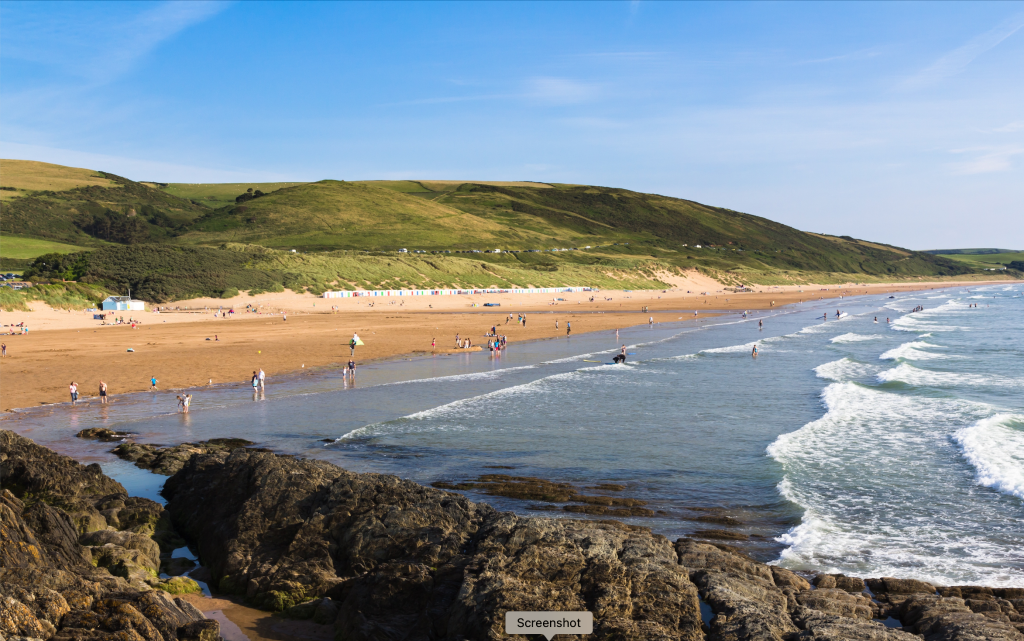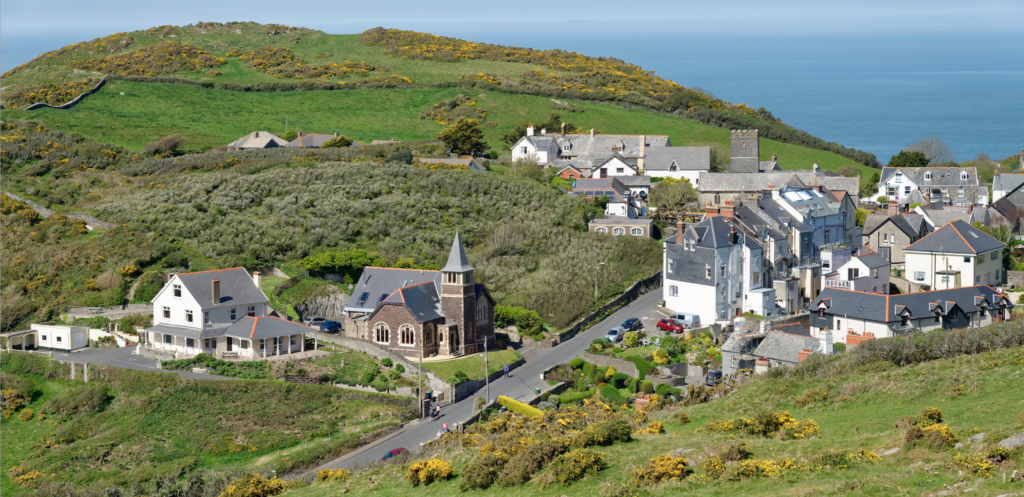Discover Woolacombe & Mortehoe

Woolacombe and Mortehoe are villages lying side-by-side on the North Devon coast, with Woolacombe the younger of the two. Until the late 1880s it was little more than its Barton Farm and a few cottages.
St. Mary’s Church dating back to Norman times. Both villages form Mortehoe Parish, administered by a Parish Council and its Clerk. Ecclesiastically, however, the villages are separate, each with its own parish church.
Things changed dramatically for the area when the railway came to Mortehoe in 1874, enabling people to travel from Waterloo on direct trains. The boom had begun! Mortehoe’s station was on the Barnstaple to Ilfracombe part of the railway and was situated two miles from the sea – a long way to walk to either village. But this actually was a positive in several ways, for it provided employment for many of the local men who acted as taxis with their wagons and carts – they advertised as ‘meeting every train’. Their wives and other local women started catering for visitors, advertising ‘Apartments and Attendance’. Sadly, the railway fell victim to Beeching’s axe in 1970. Oh, that it had not – what a wonderful holiday attraction it would be these days.
The station is mentioned in Flanders and Swann’s ‘Slow Train’, in which it’s split into Mort – e – hoe (pronounced Morty Hoe).
Some of the older locals refer to Mortehoe simply as ‘Morte’; the northern part of the village was once a separate hamlet known as North Morte. (‘Combe’, on the other hand, doesn’t refer to Woolacombe, but nearby Ilfracombe!)
Most of the land around the two villages belonged to the Chichesters, whose family seat was Arlington Court, a few miles from Barnstaple. When Sir Bruce Chichester, the last male of the line, died, his Estate passed to his unmarried daughter Rosalie, and it was she who put in motion the next development in the tourism industry that dominates the area today. She and her mother sought to develop the area in order to pay off the debts that Sir Bruce had left. Rosalie let it be known that she was willing for local women to provide and serve
refreshments on Barricane Beach, a small cove on the sea-front noted for its shells. (Over 50 varieties can be found – not all at once though – it takes some years to find examples of them all!) At the same time her land agent published a notice offering opportunities for people to set up, for a fee, tents and huts on the Sands.
In Mortehoe, an enterprising resident, Eliza Yeo, began to cater for visitors, taking people up and down the steep Chapel Hill in a simple carriage/bathchair pulled by a donkey. She can be seen as a pioneer in this new industry – so, two women at opposite ends of the class system: one a member of the aristocracy and the other a peasant woman.
Both villages grew – in a limited fashion in Mortehoe, where, firstly, dwellings were built on steep cliffsides, and much more extensively in Woolacombe, which was able to grow outwards and upwards from the central Barton Farm that lay in a flat valley.
Another giant step forward in the history of the two villages was when Rosalie bequeathed almost all her land to the National Trust. She died in 1949, at Parade House, her ‘summer residence’.
The Trust looks after its bequest to this day, encompassing beautiful tracts of land with glorious views that attract walkers by the thousand. Morte Bay lies protected between Baggy Point and Morte Point; to the north, stretching further along, is Bull Point with its now-automated lighthouse a mile or so on from North Morte Farm, now a holiday park. Facing due west from Woolacombe is the island of Lundy, approximately 18 miles away. Beyond that – America!

Before Miss Chichester bequeathed her Estate to the National Trust she had sold Woolacombe Sands, the resort’s main beach, and the clifftop known as The Greensward, to Parkin’s Entertainments, now known as Parkin’s Estates. Some years ago Stanley Parkin
commissioned and erected on The Greensward two very moving WW2 memorial stones, acknowledging the part played by thousands of American soldiers who trained here in the run-up to D-Day in June 1944.
More recently, Parkin Estates unveiled just above the beach a set of large ceramic tiles, carrying text and illustrations, that tell the history of the parish. They are designed like the pages of a book.
Other hints to the history of the two villages are many references to the Chichester family. There are no official blue plaques to locate, but Parkin Estates have their own blue plaque at the site of what was the Lifeboat House near the entrance to the beach. There are various memorial plaques that tell of the development of the area – for instance at Woolacombe’s St. Sabinus’ Church, for which Miss Chichester gave the land, the stone from her quarry and laid the foundation stone; Latin inscriptions on the stone gateposts of what was then known as Morte Point Memorial Park, given by the Chichester family, and a plaque at Potter’s Hill commemorating the Jubilee of King George V in 1935.
Miss Chichester’s summer residence, Parade House, occupies a prime position, facing due south over the Sands to Baggy Point and is now owned privately, providing holiday accommodation. The two main hotels, both of them beauties, are the Woolacombe Bay Hotel, which was the WW2 Headquarters of the American forces training here * and occupies an extensive site just 100 yards from the old Barton Farm, and the Watersmeet Hotel which lies at the other end of Morte Bay, facing due south, and is tucked under the steep cliffs that lead up to Mortehoe: it was one of the hotels that housed evacuees during the war. Several schools uprooted themselves and moved lock, stock and barrel to Woolacombe and Mortehoe for the duration. The Museum has copies of pieces written by people who came here during the war.
*The Woolacombe Bay Hotel has a brass plaque commemorating this, affixed to the inner side of the front door.
There’s a lot of history in the air around both villages!
Sue Hill, Trustee, 2024